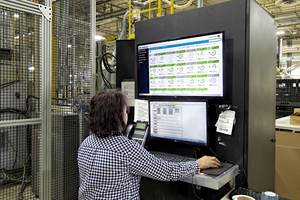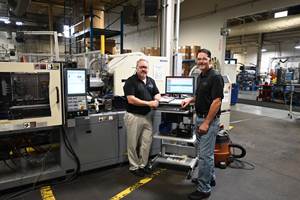Microcellular Foam Promises Big Savings in Injection Molding
Automotive parts supplier Injectronics Inc. in Clinton, Mass., will soon be the first injection molder to use a new microcellular foam technology developed by Trexel Inc., Woburn, Mass.
Automotive parts supplier Injectronics Inc. in Clinton, Mass., will soon be the first injection molder to use a new microcellular foam technology developed by Trexel Inc., Woburn, Mass. "We are looking for innovations that reduce price," says Injectronics president Paul Nazzaro. Weight reduction, faster cycles, and ability to use machines with less clamp force are among the benefits that the firm expects from Trexel's MuCell continuous foaming process.
The microcellular process, initially developed for extrusion, was recently extended to injection molding through a commercial agreement between Trexel and Engel Canada Ltd., Guelph, Ont. The MuCell process works by heating and pressurizing a non-flammable gas such as carbon dioxide or nitrogen to a supercritical state, which has characteristics similar to a fluid. This foaming agent is then injected into the plastics melt.
The MuCell process is said to yield uniform closed cells as small as 10 microns. Density reduction of up to 40% is reportedly possible. But the tiny, uniform cell structure helps retain higher properties at lower densities than is seen with conventionally foamed parts. That allows molding thin, light parts that are not brittle, says David Bernstein, Trexel president and CEO. The reduced amount of resin in the parts also helps reduce cycle times.
In addition, the process reduces clamp-tonnage requirements for molding. That is because the super-critical foaming agent acts as a solvent, which lowers the viscosity of the material by 40-60%, so lower pressure is required to push the material into the mold cavity. The process can be run at temperatures as much as 140 F below normal. Injectronics plans to run parts designed for a 500-ton and 300-ton press on a 200-ton modified Engel tiebarless press, which will be delivered in June.
Prototypes hold promise
Injectronics plans to use MuCell technology as a tool for innovation in its line of HVAC units, which make up approximately 80% of the firm's $30 million in annual sales. Injectronics is a Tier One OEM supplier of HVAC parts to Daimler Chrysler, Ford, and a subcontractor to GM, says Nazzaro. The firm is working on Chrysler's 2001 and 2002 vehicle programs. "We expect a 15-20% reduction in cycle time, a 30% reduction in operating pressure, and 25% lower operating temperature," says Peter Glekas, Injectronics' director of new technology.
Glekas is impressed by prototypes of two HVAC products produced with MuCell technology at Trexel's plant, using a single-cavity mold on a 150-ton Engel machine. "Daimler Chrysler HVAC parts are averaging a 20% reduction in weight and shorter cycle time," he notes. Weight of a prototype blower housing in 40% talc-filled PP was reduced to 118 grams from 145 g. Injectronics engineers were especially impressed with the tight dimensional tolerances they have seen on large flat MuCell parts because such shapes are often troublemakers for conventional injection molding. In one instance, Injectronics tested a large flat door where the MuCell process made it possible to switch from a 40% glass- and mineral-filled nylon 66 to a nylon compound costing two-thirds as much and based partly on recycled material.
Injectronics will convert a number of automotive items to MuCell, such as blower-cover assemblies, overmolded doors, levers, valve flapper gates, radiator shields, and scuff plates. Ten or 15 vent doors will also be converted to the MuCell process, and five motor-housing projects are already under way. Other potential candidates for conversion include steering-column shrouds and instrument panels.
Not like structural foam
"The MuCell foaming process is different from low-pressure structural foam in that a uniform, single-phase solution of blowing agent and polymer is created and maintained before it is injected into the mold," says David Pierick, v.p. for injection molding at Trexel.
In conventional structural-foam molding, the cellular structure arises at the end of flow, which results in a non-uniform cell structure. Structural-foam processes usually require the mold to be filled 85-95%, and then the foam expands to fill the remainder. With the MuCell process, the mold is filled 100%. "We don't short-shoot the mold," Pierick says. After molding, the gas slowly dissipates through the polymer into the atmosphere.
Bernstein says the MuCell process has a wide processing window, which permits using a broad range of materials, including filled grades. Trexel has injection molded parts with materials such as nylon, PP, PC/ABS blends, santoprene, and acetal.
Machine & mold requirements
In the modified Engel press to be used by Injectronics, the super-critical fluid is injected into the already plasticated melt stream through a proprietary delivery system. Other modifications include a special screw, some changes in the hydraulic system, and control software that ties delivery rate of the super-critical fluid with the speed of injection. Trexel says it would like to reach agreements with other injection molding machine suppliers to modify their equipment for the MuCell process.
"We have not had to make any changes to any production tool to run the MuCell process in lab tests," says Pierick. "Every mold we have brought into our facility has worked without having to make modifications." On the other hand, Trexel's Bernstein says thinner molds may be designed for MuCell parts in the future because the operating pressures required are so much lower. Injectronics will run two- and four-cavity molds when it uses the new technology in production. Meanwhile, Trexel has completed tests with a 64-cavity tool.
Glekas notes that there is one tooling limitation: In order to keep the super-critical gas from escaping, a cold runner is more suitable than a hot runner, unless the latter has valve gates with a positive shutoff. Injectronics will use both approaches, Glekas says.
Related Content
Neste, Borealis and Covestro Plan to Make Polycarbonate From Recycled Tires
Companies announced agreement that will use advanced recycling to convert old tires into new PC-suitable for automotive applications.
Read MoreNew CRM Streamlines Quoting for Automotive Molder
Eliminating the need to contact each supplier for every individual quote, a new CRM for automotive supplier Axiom Group tracks past quotes as well as industry history to generate fast, reliable RFQs and more.
Read MoreAtop the Plastics Pyramid
Allegheny Performance Plastics specializes in molding parts from high-temperature resins for demanding applications as part of its mission to take on jobs ‘no one else does.’
Read MoreGlass Fiber-Reinforced PP With PCR For Automotive
Borcycle GD3600SY will appear in Peugeot vehicles.
Read MoreRead Next
Beyond Prototypes: 8 Ways the Plastics Industry Is Using 3D Printing
Plastics processors are finding applications for 3D printing around the plant and across the supply chain. Here are 8 examples to look for at NPE2024.
Read MorePeople 4.0 – How to Get Buy-In from Your Staff for Industry 4.0 Systems
Implementing a production monitoring system as the foundation of a ‘smart factory’ is about integrating people with new technology as much as it is about integrating machines and computers. Here are tips from a company that has gone through the process.
Read More



















